In sharing her own remarkable story, Leang Peou, a librarian at State Library of Queensland, gives us valuable insight into immigration to Australia from Asia, and some useful resources for discovering records and family connections.
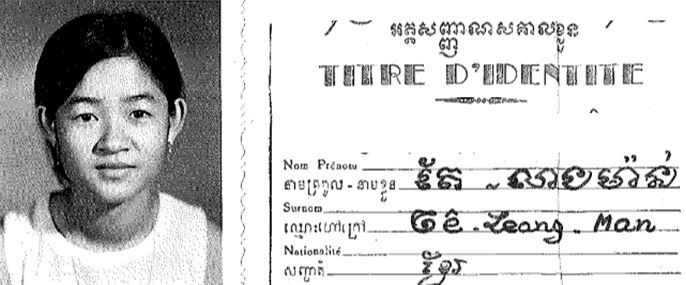
Leang's Cambodian identity card.
The Immigration Museum of Victoria states that “there was very little Cambodian immigration to Australia until the 1950s when a small number of students from Cambodia arrived under the Colombo Plan. The Colombo Plan was established in 1950 and encouraged economic and social cooperation between member countries in the Asia-Pacific region. It included a scheme under which students from developing countries could study in Australia”.
Historically, Cambodia was a member of the Colombo Plan. According to a Wikipedia article, Cambodia first joined the Plan in 1951.
I came to Australia from Cambodia on 11 March 1975, under the auspices of the Colombo Plan, to attend a short course in teaching English as a second language. From 1972 to 1975 I taught English as a foreign language to students in Bung Trabek High School in Phnom Penh. I sat for written and oral examinations, and was selected with another four candidates out of many applicants.
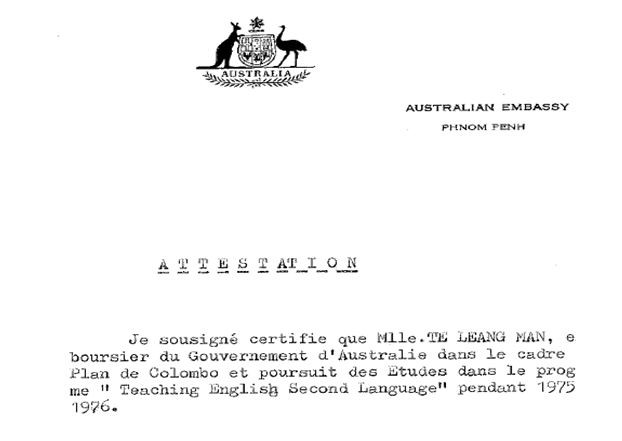
Letter from the Australian Embassy in Phnom Penh to say that Leang had been awarded a Colombo Plan scholarship.
The journey
On 28 February 1975, I received a letter from the Australian Embassy in Phnom Penh, confirming that I was granted a Colombo Plan scholarship to come to Australia to further my study in “the teaching of English as a second language” for ten months in 1975 and 1976.
On Sunday 9 March, we received the stamp of approval from the embassy to enter Australia (visas). We had a few hours to pack before we had to fly out with the Royal Air Cambodge.
Family and friends were not able to go to the airport to say goodbye as we were under heavy bombardment from the Khmer Rouge. My father saw me off at the airline office in the city. We were driven in a minivan right up to the steps of the plane, boarded it as fast as we could, and the plane immediately took off. We felt an immense sense of relief once we were safely up in the air. We arrived in Singapore on 9 March, and in Perth on 11 March at 3am.
The experience of arrival
After landing, we were greeted by officers from the Department of Education, and I was brought to my host family's home by an officer. We went through an induction course the next day. The following day we commenced our course at the Western Australian Institute of Technology (now known as Curtin University) with other teachers from Fiji, Tonga, Western Samoa, Indonesia, Korea, Kenya and Tanzania.
We were treated like VIPs, as we were all government officials. We were introduced to the Australian way of life, including its natural environment and general infrastructure, through organised trips to Kalgoorlie, national parks to see wild flowers, and a walk on tree top bridges. We were very impressed with all the help and attention bestowed upon us, especially the organised and peaceful lifestyle, the country's natural beauty and cleanliness.
Assisted migration
On 17 April 1975, about one month after our arrival, Cambodia was overthrown by the communist Khmer Rouge movement led by Pol Pot. We lost touch with our families. Towards the end of the course, we had no country to return to and we were then granted permanent residency. I became, in effect, an assisted migrant.
New life, new hope, new status
To become a qualified teacher I needed to complete a Diploma in Education at Mt Lawley College of Advanced Education (now known as Edith Cowan University, Mt Lawley campus). Before the new course started, I applied and got a job at Cocklebiddy Road House. I went there by coach and started working the next day, making hamburgers, coffee etc. That morning the employer was asked by the Western Australian Government to send me back to Perth on the next coach available.
I became an Australian Citizen in 1978. In 1985, through the Red Cross Tracing Bureau, I was able to contact my family. They had returned home after being forced on a long march to work on rice fields near the border. My father did not survive the harsh treatment of hard labour with no food. He was buried in an unmarked mass grave.
In 1988, my mother, brother and four sisters were allowed to come to Australia under the Family Reunion Scheme. They were unassisted migrants. The Colombo Plan Scholarship, in my case, turned out to be an immigration scheme and a life saver for me and my family.
My host family, Pam and Jim Blackford of Western Australia, played a great part in my settling down in Australia, and I’m forever very grateful for their kind support and guidance. We still keep in touch.
What information can be found at State Library of Queensland and the National Archives of Australia?
State Library of Queensland holds many journals, reports and pamphlets on the Colombo Plan Scheme and its many projects. More information can be found via our One Search catalogue.
The National Archives of Australia (NAA) also hold many documents, including photographs of people who came to Australia under the Colombo Plan Scheme, and information about what they did when they returned to their homelands.
To search, I logged on to the NAA website, selected Search the Collection then RecordSearch. This took me to the basic search screen as seen below. I used the key words “Colombo Plan Cambodia”.
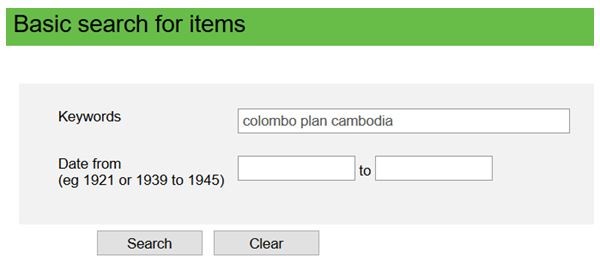


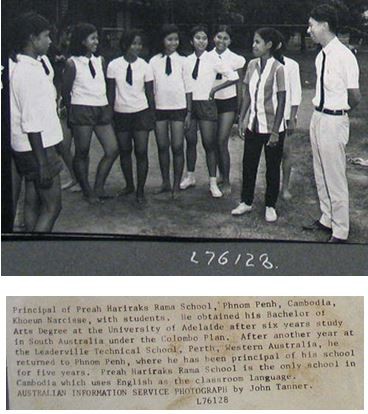
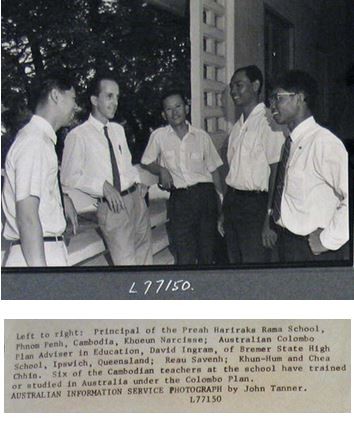
Leang's high school teachers and principal. Image courtesy of National Archives of Australia.
From this document I found the photographs of the following Cambodian Colombo Plan scholarship holders:
- Chea Chhin (Sydney 1967)
- Khun Hum (Sydney 1967)
- Khoeun Narcisse (SA, WA, 196?)
- Reau Savenh (SA 1968)
- Lay Loeung Chun (Brisbane 1965/66)
- Khuan Khay (aka Khan Khay) (Brisbane 1965/66)
- Uch Ban
- Vann Uma Vikramuditt (Sydney)
- Tra-Rong (Sydney 1963, 1967)
- Lim Sainvar (1966)
To search for documents through the National Archives of Australia website, select Search the Collection, then RecordSearch to take you to the basic search screen. You may use different key words according to the topic of your research.
If you would like to obtain your case migration files from the National Archives of Australia, you can use their Ask us a question service. National Archives of Australia hold very valuable collections of records, and you will be amazed at what you can find.
Leang PeouLibrarian, Information Services
Leang’s husband, Dr Sarum Peou, also came to Australia on a Colombo Plan scholarship. He continued on to complete a Masters degree and a PhD, and had a distinguished career as an expert in coal exploration geology, working in the mining industry, as an academic and author, until he died in 2003. His papers are part of the Dr Sarum Peou Collection held by State Library of Queensland.
Useful links
http://www.redcross.org.au/about-us.aspx
Cambodia. (1970). Marine Corps Gazette (Pre-1994), 54(6), 29-31. Retrieved from http://ezproxy.slq.qld.gov.au/login?url=http://search.proquest.com.ezproxy.slq.qld.gov.au/docview/206304040?accountid=13378
Colombo Plan. (2016). In Wikipedia. Retrieved 8 June, 2016, from https://en.wikipedia.org/w/index.php?title=Colombo_Plan&oldid=719930318
Immigration Museum, Victoria (2009). Cambodian Immigration. Retrieved from https://museumvictoria.com.au/immigrationmuseum/discoverycentre/your-questions/cambodian-immigration/
Larsen, G. (2013). Family migration to Australia. In Parliament of Australia. Retrieved 8 June, 2016 from http://www.aph.gov.au/About_Parliament/Parliamentary_Departments/Parliamentary_Library/pubs/rp/rp1314/FamilyMigration
National Archives of Australia: http://www.naa.gov.au/
Pol Pot. (2009). In History.com. Retrieved 8 June, 2016 from http://www.history.com/topics/pol-pot
SLQ’s One Search catalogue: http://onesearch.slq.qld.gov.au/primo_library/libweb/action/search.do?vid=SLQ&fromLogin=true
Comments
Your email address will not be published.
We welcome relevant, respectful comments.